| Reviews Archive |
| |
Midnight Resistance |
| |
|
| |
| |
Graphics |
| |
|
|
|
|
| |
|
C64 |
Spectrum |
Amstrad |
| |
|
|
|
|
| |
|
 |
 |
 |
| |
|
| |
|
|
|
|
| |
|
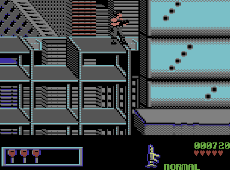 |
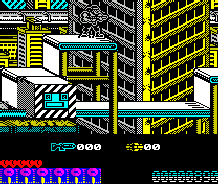 |
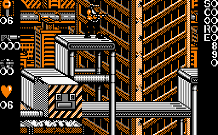 |
| |
|
| |
|
|
|
|
| |
|
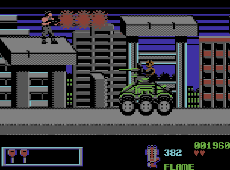 |
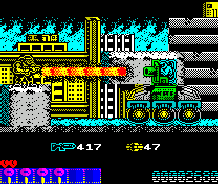 |
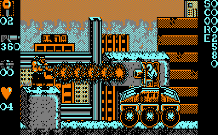 |
| |
|
| |
| |
| |
|
|
|
|
| |
|
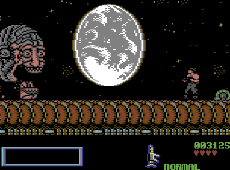 |
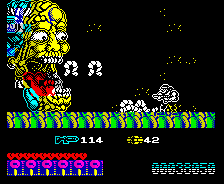 |
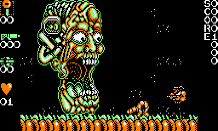 |
| |
|
| |
|
|
|
|
| |
Detail |
| |
C64 - Everything here is quite respectable, but the C64 version definitely has the lowest level of detail out of the three. This version runs in the lowest resolution of the three games, the backgrounds are more basic, and angular, and the texturing is much more sparse, the main character himself is also lacking in definition in comparison to the other versions.
Bosses here are notably smaller than they were in the arcade original, and are also smaller than those of the Spectrum and Amstrad (See screenshots 2 and 3), sprite flicker is also apparent when there's a lot going on on-screen.
Spectrum - The designers did a really excellent job on the backgrounds here, they're distinctive, highly detailed, and full of nice little elements (if you look carefully at the waterfalls on level 4 the Spectrum version actually has little fish jumping in and out for instance). The sprites are a little more stylised and cartoony, but personally I think they all look great, to me the main character is mildly reminiscent of the sprites used in the popular Metal Slug series.
Amstrad - The Amstrad version looks to be a direct port of the Spectrum version, and generally has an almost identical level of detail, if you look carefully though there are a few changes in detail (looking at screenshot 1 for example the ground the player is standing on has some simple line texturing added to it). Some sections have a few of these minor extra elements over the Spectrum version, whilst others have less. The main character sprite has also been changed and is now thinner than before, causing his right arm to look a little out of proportion in my opinion. |
| |
| |
Winner Is: Draw between the Spectrum and Amstrad versions |
|
| |
-------------------------------------------------------------------------------------------------------------- |
| |
Colour |
| |
C64 - Very respectable colour use. Its possible it could've been better (some sections look a little drab), but all in all the C64's gritty palette seems to fit the game fairly well.
Out of these three versions this is easily the best by quite a notable margin as everything is realistically coloured with few compromises (no bright orange, or bright yellow trees here), and there's no clash issues.
Spectrum - Colours here are very garish and used quite sparingly. There's a lot of unrealistically coloured areas and a preponderance of yellow and turquoise sections, but dabs of colour add some variation where needed.
Colour clash problems are very much evident here, with the player sprite effectively being transparent at all times, but the programmers have been very careful not to let it affect gameplay. Bullets are big, colourful, and easy to see.
Amstrad - This uses the Amstrad's high resolution mode, which unlike the Spectrum has a limitation on how many colours it can put on-screen (4 vs 15), as such the colour counts have been dropped for this version. The lower colour counts are definitely quite noticeable when playing through the game, but the programmers have actually made some effort to optimise, as this version has tons of dithering added to it in an effort to make it appear to have over 4 colours.
The colours used for this version are different to the Spectrum version, but are usually just as garish. For the most part the yellow of the Spectrum game has just been replaced with a lot of bright orange which looks just as bad, but the areas which are suited to low colour counts (such as the hangar and underground bunker sections), actually look better here, using the Amstrad's detailed colour capabilities to simply shade the backgrounds nicely with lots of grays.
Lastly, the Amstrad doesn't suffer from the Spectrum colour clash issues, the sprites here are not transparent. |
| |
| |
Winner Is: C64 |
|
| |
-------------------------------------------------------------------------------------------------------------- |
| |
Animation |
|
| |
C64 - Fast, smooth animation with lots of frames, first rate job.
Spectrum - Good, nowhere near the level of the C64 version but the character still looks pretty good in motion.
Amstrad - Not bad, but it doesn't seem to be as well animated as the Spectrum version for some reason. |
|
| |
|
| |
Winner Is: C64 |
|
| |
-------------------------------------------------------------------------------------------------------------- |
|
| |
Scrolling |
|
| |
C64 - Very nice, smooth scrolling, it would be pretty much faultless in this area if it wasn't for the fact that you can out-run the scrolling if you drop too quickly (more on that later).
Spectrum - Unfortunately the scrolling is one of the worst aspects about the Spectrum version, its very jerky and the screen is pushed forward, instead of smoothly moving along with the character. The scrolling is very ugly, but after a while you get used to it, and fortunately it doesn't affect the gameplay too much.
Amstrad - Pretty much the same as the Spectrum, but slower. |
|
| |
|
| |
Winner Is: C64 |
|
| |
|
|
| |
Sound |
|
| |
|
|
| |
Music |
|
| |
C64 - The original arcade version had some awesome, and memorable music, and the C64 doesn't disappoint with its excellent arrangements. A few of the tunes can start to grate after extended playing, but its a minor criticism when the general quality is this good. The music is also dynamic, changing whenever you run into a boss.
Spectrum - Very impressive stuff, definitely some of the best music ever to appear in any Spectrum game. It nearly manages to hold it's own against the excellent C64 version's music, and has its own distinctive sound, but the drums are a little weak, and the music sounds slightly simpler as it has a little less going on in it.
Amstrad - Unfortunately apart from the title screen, music is entirely absent from this version. |
|
| |
| |
Winner Is: C64 |
|
| |
-------------------------------------------------------------------------------------------------------------- |
|
| |
Sound FX |
|
| |
C64 - Really good sound effects, everything sounds as it should.
Spectrum - Pretty bad really, gunfire sounds more "squelchy" than anything else, and nothing sounds like it should.
Amstrad - Not bad at all, not quite as good as the C64's but it still does the job rather nicely. |
|
| |
|
| |
Winner Is: C64 |
|
| |
|
|
| Gameplay |
Midnight Resistance was an arcade run n' gun game similar in many aspects to the popular Contra. The gameplay has you running through the stages dispatching numerous enemies, and using a variety of different weapons along the way. There are two main differences between Midnight Resistance, and Contra. Firstly in Midnight Resistance you collect keys from defeated enemies which are used as currency to purchase weapons between each stage, and secondly the original arcade machine used a controller with a dial that allowed you to move and fire in different directions independently. The game is fast, frenetic, and action-packed, the weapons are powerful, are fun to use, and include a lot of variety with different weapons suited to different occasions.
C64 - The Commodore version is a lot of fun to play, its smooth and slick, has very responsive controls, and most of what made the original game great is retained. Its definitely one of the better action games on the system.
However, whilst the controls are responsive, the main player here jumps much higher than usual, and each jump has a restrictively long amount of air-time, on top of this, due to the lack of the arcade's dial controller it's difficult to fire upwards without jumping (you have to hold fire and then aim upwards here). Firing forwards whilst running backwards, and firing upwards whilst moving are impossible in this version (this second point especially makes some sections, and boss fights more difficult). The pacing of this version is noticeably more sedate than the others, enemies tend to be more spaced out, and every now and then you come to areas which are a little empty.
All three versions have inaccuracies (such as the gears on level 6, which can be avoided in all versions simply by ducking), but the C64 version has the highest number of them. Some of the problems I've noticed here are that the conveyer belts which are supposed to be in the first level are replaced with moving gears recycled from level 6, the lift area in level 2 only includes one platform instead of the original four (which makes this section much more cramped), and in this version many of the boss fights are much easier (for instance you can shoot the first level tank from below from out of harms way, and you can destroy force fields simply by shooting at them, instead of destroying their generators above and below). One of the last problems I noticed here is that you can out run the scrolling, which leads to losing a life.
The weapons in this version are downgraded, and don't quite retain the feeling of power present in the other versions. The flamethrower here reaches only half the distance, and is next to useless as a result (see screenshot two for a comparison of the full distance of each version). The homing weapon fires only 3 shots instead of 5, and the accuracy is quite poor (often they'll just circle around you ineffectually). The "shower" weapon fires 3 blasts instead of 8 (covering very little screen real estate), and the Nitro fires three shots instead of 5 (though this weapon retains its usefulness).
Spectrum - The pacing here is much faster than the C64 version, with you progressing through the levels at a more rapid pace, and the enemies rarely giving you time to breath.
The controls are a little more sluggish than those of the C64, and like the C64 the inability to run backwards whilst firing forwards is also present, but on the upside the jumping height, and speed are easier to handle, and unlike the C64 version they've changed the normal gun to rapid fire, and allowed the player to hold down fire and run forwards whilst firing up, which was impossible to do in the C64 game (in that version you have to stand stationary to fire up, otherwise you jump into the air), these two elements do a great deal to offset the more sluggish controls, and overall I would say that the Spectrum version, after some initial perseverance, controls the better.
The power-ups and enemies retain their "over the top" arcade feel in the Spectrum/Amstrad versions, with them all bearing much closer resemblance to their source material than those of the C64 version (Shower fires 8 blasts, Nitro fires 5, the flamethrower's reach is much further, and the homing rockets are more numerous and lock-on better).
Amstrad - Generally this plays very much like the Spectrum version, but is noticeably slower. |
| Winner Is: Spectrum |
| |
| Presentation |
C64 - Originally the arcade game started with you entering the first stage on a jeep, this element is missing from the C64 version, there was also a quick intermission on the last level which had the antagonist appear on a screen in the background to threaten your family, which is also missing here.
Spectrum - This version includes both the car, and the cutscene.
Amstrad - The same as Spectrum |
| Winner Is: Draw between Spectrum and Amstrad |
| |
| |
|
| |
Conclusion |
|
| |
Between the Amstrad and Spectrum versions it not that difficult a decision, graphically there's some tradeoffs between the two, but neither decisively comes out on top. In all other areas the Amstrad comes out a little worse off, its missing the excellent music, which hurts its atmosphere, and it plays noticeably slower too.
The C64 version is probably the more polished of the three versions, due to its smooth movement and responsive controls, but the Spectrum/Amstrad games have a better moveset, and are more frenetic, and more over-the-top due to their powerful weapon upgrades and bigger, more intimidating boss fights (the final boss fight in the C64 version is especially anti-climatic, looking more like the disembodied head of a poor senile old man who doesn't know what's going on anymore than the monstrous final boss it's supposed to be). The weapons on the C64 version are weak, containing none of the power of the arcade originals, and are heavily skewed towards two or three different items, whilst on the Spectrum/Amstrad they are better balanced, and are all viable choices. which add to variety.
So in closing, all versions of the game are actually very good (albeit the Amstrad version, whilst playing well, very much under-utilises the hardware), but I just find the Spectrum version to be the best paced, and most fun to play. |
|
| |
Overall Winner Is: Spectrum |
|
|
|
|
|